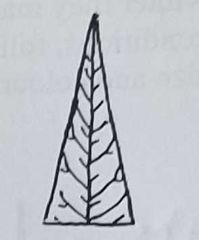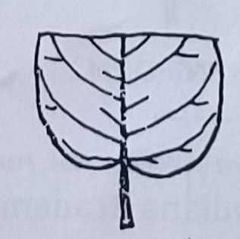![]()
![]()
![]()
Use LEFT and RIGHT arrow keys to navigate between flashcards;
Use UP and DOWN arrow keys to flip the card;
H to show hint;
A reads text to speech;
106 Cards in this Set
- Front
- Back
|
3 ways hardiness zones can be identified |
1. Using indicator plants 2. Compare avg min temp of area to temp designations for zones 3. Studying hardiness map |
|
|
Other factors which influence plant hardiness (7) |
Wind Light Moisture Humidity Nutrients Pests / diseases Soils |
|
|
How can growers adapt plants for intended use (4) |
1.Increase/decrease temp 2.Alter light intensity and duration 3.Changing amount and frequency of watering 4.Altering amount of nutrients |
|
|
Pedicel |
Flower stalk |
|
|
Peduncle |
Flowers born directly from stalk (no pedicel) |
|
|
Receptacle |
Part of flower that bears male and female parts |
|
|
Perianth |
Collective term for petals + sepals |
|
|
Calyx |
Outer petals / collective term for sepals |
|
|
Sepals |
Individual outer petals |
|
|
Corolla |
Collective term for inner petals |
|
|
Tepals |
petals and sepals that look the same |
|
|
Androecium |
Collective tern for male parts |
|
|
Stamen |
Anther + filament |
|
|
Filament |
Holds the anther |
|
|
Anther |
Contains pollen |
|
|
Gynoecium |
Collective term for female parts |
|
|
Pistol |
Stigma + style + ovary |
|
|
Stigma |
Where pollen grains are received |
|
|
Style |
Carries pollen to ovary |
|
|
Ovary |
Where seeds are developed |
|
|
Monocarpic plant |
A plant that only creates flowers and seeds once in its lifetime, and then dies |
|
|
Annual |
A plant that completes its life cycle in the span of one growing season, and then dies. |
|
|
Axil |
The angle between the petiole and the stem |
|
|
Blade |
The portion of the leaf that performs photosynthesis |
|
|
Biennial |
A plant that takes two years to complete its life cycle, and only flowers once. Needs one cold period and two warm |
|
|
Compound leaf |
A style of leaf in which the blade is completely subdivided into leaflets |
|
|
Binomial |
System of scientific naming with primarily two words (genus and species) |
|
|
Conifer |
An order of trees and shrubs that have scale-like or needle foliage, are usually evergreen, and produce cones. |
|
|
Dehiscent |
fruits that split to allow seeds to fall out |
|
|
Indehiscent |
Fruits that do not split |
|
|
Exfoliate |
The loss or removal of leaves from a plant |
|
|
Evergreen |
Plants whose foliage remains functional and green all year round. |
|
|
Family |
A grouping of plants that are divided based on differences in seed, fruit, and flower. After order before species |
|
|
Floret |
A small flower among many that together form a compound flower head |
|
|
Pinnate (net) |
A style of venation in which the veins divide out from a central midrib |
|
|
Genus/genera |
A class organized below Family and before species, in which members are grouped based on similarities |
|
|
Glabrous |
A plant completely devoid of pubesence |
|
|
Glacous |
An adjective to describe a plant surface that is covered in a waxy, mealy, glue/grey/white coating that is easily wiped away. |
|
|
Hardiness |
The ability of a plant to survive adverse conditions. |
|
|
Herbaceous |
A type of plant tissue that is soft and succulent instead of woody. |
|
|
Inflorescence |
The arrangement of flowers on a plant |
|
|
Herbarium |
A collection of dried plants, usually organized by a common theme. |
|
|
Trifoliate |
A type of compound leaf consisting of three leaflets |
|
|
Venation |
The pattern of veins on a leaf |
|
|
Leaflet |
The leaflike portions of a compound leaf, which are completely subdivided and attached at the rachis |
|
|
Cultivar |
A plant variation that does not occur naturally in nature, has been developed from the result of human influence, and will not persist outside of cultivation. |
|
|
Node |
The section of a stem where a leaf and an axillary bud form together. |
|
|
Midrib |
The main vein that runs from the base of a leaf blade to the tip. |
|
|
Opposite |
An attachment style of leaves to stem, in which two leaves are connected at the exact same spot but opposite to each other |
|
|
Perennial |
A plant that lives for longer than two years/growing seasons. |
|
|
Petiole |
Leaf stalk |
|
|
Pinnately compound |
A style of compound leaves in which the leaflets attach to the stem on opposite sides, occasionally in pairs |
|
|
Pubescent |
An adjective that describes a plant surface that has hairs of any types |
|
|
Rosette |
Leaves or leaflike structures arranged in a circular pattern. |
|
|
Rugose |
An adjective describing a plant surface in which the veins of a leaf are sunken and the spaces between are raised, giving the appearance of wrinkles. |
|
|
Sessile |
A flower or leaf that has no stalk, and is instead attached directly to the stem |
|
|
Shrub |
A woody plant that has several main stems near the ground and is smaller than a tree. |
|
|
Raceme |
A flower cluster consisting of short stalks attached to a central stem at equal distances. |
|
|
Sinus |
The space between two lobes/teeth. |
|
|
Specimen plant |
A plant grown to show its full potential for exhibition |
|
|
Rachis |
The portion of a petiole that the leaflets are connected to. |
|
|
Stipule |
The paired, leaflike appendages, often at the base of the petiole |
|
|
Tender |
A plant that is not cold tolerant. Even the slightest frost or cold will kill it |
|
|
Tree |
A woody perennial, usually with a large trunk and branches. |
|
|
Variegation |
A leaf that has secondary colours, often whitish or other greens. |
|
|
Form (2) |
One of the taxonomic ranks; above variety and below species.The abstract element of how a plant looks in a landscape.
|
|

|
Aricular |
|

|
Cordate |
|

|
Elliptic |
|

|
Lanceolate |
|

|
Linear |
|

|
Oval |
|

|
Orbicular |
|

|
Oblanceolate |
|

|
Ovate |
|

|
Reniform |
|

|
Runcinate |
|

|
Sagittate |
|

|
Spatulate |
|

|
Acute |
|

|
Accuminate |
|

|
Bristle-tipped |
|

|
Truncate |
|

|
Obtuse |
|

|
Cuneate |
|

|
Obtuse |
|

|
Cordate |
|

|
Truncate |
|

|
Oblique |
|

|
Entire |
|

|
Undulate |
|

|
Finely serrate |
|

|
Coarsely serrate |
|

|
Doubly serrate |
|

|
Crenate |
|

|
Lobed |
|
|
Bipinnately compound |
Leaflets have leaflets |
|
|
Monocot vs dicot net |
Monocot = parallel Dicot = pinnate or palmate net |
|
|
Pulvinis |
Where vascular bundles of petiole meet stem |
|
|
Simple |
Leaf not divided into leaflets |
|
|
Monoecious |
Plants that are both male and female |
|
|
Dioecious |
Plants that are either male or female but not both |
|
|
Perfect flower |
Flower that contains both male and female parts |
|
|
Imperfect flower |
Flowers that are entirely male or female |
|
|
Complete |
Flower has 4 whorls |
|
|
Incomplete |
Flower has less than 4 whorls (missing some) |

